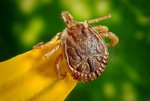 Narrowsburg
NarrowsburgLight Rain Fog/Mist, 43°
Wind: 8.1 mph
 Narrowsburg
NarrowsburgTick-borne infections are on the increase, and our offices in Sullivan and Orange counties have seen the numbers rise every year. The New York State Department of Health has been reporting more and …
Stay informed about your community and support local independent journalism.
Subscribe to The River Reporter today. click here
This item is available in full to subscribers.
Please log in to continue |


Tick-borne infections are on the increase, and our offices in Sullivan and Orange counties have seen the numbers rise every year. The New York State Department of Health has been reporting more and more cases across the state, especially in the Hudson Valley region.
As those numbers continue to rise, it isn’t just Lyme disease we are diagnosing and treating anymore. Newer, emerging infectious diseases, such as anaplasmosis and babesiosis are being seen on a regular basis. These three infections, Lyme, anaplasmosis and babesiosis are all carried by the same deer tick that is so common to the Hudson Valley and Catskills.
The tick time of year. In recent years, tick season seems to have taken up a larger part of the calendar year. Ticks hibernate in the winter by burrowing in the ground. They like the warmer weather, and as soon as temperatures reach 40° for a span of three consecutive days, they dig their way out and begin searching for their yearly meal of blood. This year, Catskill Regional and Orange Regional began seeing patients arrive with tick-related infections as early as April. Last season, we saw deer tick bites well into November.
Where ticks hide. When ticks and the illnesses they carry first became a widespread concern, healthcare providers used to recommend avoiding areas of tall grass and lush or overgrown vegetation. Nowadays, we know that ticks can be found anywhere that deer or field mice can carry them. That can be just about anywhere. There are ticks even on a nicely manicured lawn.
I recommend to patients that every time they come back inside, they should check themselves. Ticks are notoriously evasive in nature and can hide on our bodies feeding without us even feeling the bite. The Centers for Disease Control (CDC) suggest paying specific attention to the scalp, arm pits, behind the ears, groin areas and behind the knees.
Ticks, hobbies and staying active. Since ticks have become so prevalent, you should exercise caution while outside enjoying nature: hiking, hunting, gardening, sports, etc. I don’t suggest anyone avoid their favorite outdoor activities altogether, but I do recommend caution and preparation. If you hike, stay toward the center of the trail; avoid leafy piles where ticks like to hang out. Choose long pants instead of shorts, socks, and opt for long-sleeved shirts. As soon as you get home, remove your clothing, shower and check for ticks. The CDC recommend placing clothes in a hot dryer to try and remove the ticks.
Timing the impact. During the first 24 hours after a tick falls on you, it explores all around your body, but doesn’t bite or start to feed on your blood right away. After that, it bites and can feed for days without your even noticing it is on you. When you find a tick, it has to be a deer tick and full of a lot of blood, or “engorged,” for you to be at risk for Lyme disease. Should you find a deer tick that’s embedded but with no blood inside of it, you shouldn’t worry about Lyme disease.
The other, less common infections, like babesiosis and anaplasmosis, can happen before the tick is visibly engorged, so it’s best to use preventive measures and check yourself to get ticks off of your body in as timely a manner as possible.
Taking a tick off. If you find a tick embedded on your body, you can remove it yourself using fine tweezers. Lift the tick up by the body, and then grasp the tick itself with the tweezer as close to its mouthpiece as you can—right where it is attached to the body. Then, just wiggle it gently to loosen and remove. If you end up leaving the mouth pieces in, don’t dig for them; it could make matters worse. Doctors no longer test ticks for Lyme disease. If the tick was engorged, you should see your doctor for a preventative one-time dose of doxycycline.
Signs and symptoms. Lyme most commonly presents with headache, neck pain and overall achy joints. You might feel tired, your muscles might be aching, and you might have a low-grade fever. You basically feel overall yucky for a week or two. Not everyone will develop the tell-tale rash, and for those who do, the rash doesn’t always look like a bull’s-eye. It can appear as a big red patch, which gets bigger rapidly, growing at least several inches across. It is also important to know that the rash is not itchy or painful. Since you may not feel the rash, it is important to look all over your body for it.
Treating tick infections. Lyme has become so commonplace that it is now diagnosed and treated by just about every type of doctor there is. You do not need to see a specialist to treat Lyme disease. Your primary-care physician is likely to be very up-to-date on the treatment of Lyme disease. Your care will be based on standard treatment guidelines and will be very straightforward based on the symptoms you have. The good news is that antibiotics cure Lyme infection. To date, there is no Lyme vaccine available for use.
[Marina Keller is director of Infectious Diseases, Orange Regional Medical Group and Catskill Regional Medical Group.]
Comments
No comments on this item Please log in to comment by clicking here